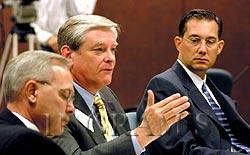
Avila College president Tom Gordon suggests the school's objective is to integrate IT while protecting exceptional student-professor interaction.
Of all the challenges facing independent institutions today, "the greatest challenge is financial," says Gordon. "The high cost of technology and competitive salaries place a strain on a budget where tuition, gifts, and grants are the only revenue sources." John Darling, interim dean of the school of management at Rockhurst University concurs. "As it has been for many years," Darling says, "funding is the greatest challenge facing private colleges and universities today. Private institutions are typically very tuition-driven with regard to their funding base."
According to the U.S. Department of Education, the price of education for the 1999-2000 academic year averaged $3,356 for public schools. For private institutions, it averaged $15,380. It's an area where private colleges and universities struggle to stay competitive, especially as the consumers of all education have seen prices soar. Between 1987 and 1996, expenditures per full-time-equivalent student rose, after adjusting for inflation, by nine percent. Tuition costs have risen at a rate of nearly eight times the rate of income over the last 20 years.
John Neal, president of Ottawa University, says private schools must remain "nimble" in such a highly competitive educational environment, and this includes serving an increasing spectrum of demands. Extending beyond the core curriculum presents its own challenges, however. Carey of Benedictine says the greatest challenge for any school is to be clear about its mission. Lambert of Baker says it is to maintain the distinctive character of the institution.